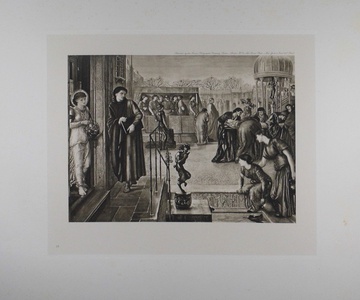| Method | Photogravure |
| Artist | after Sir Edward Coley Burne-Jones |
| Published | Published by the Berlin Photographic Company Berlin. _ London W.133 New Bond Street. _ New York 14 East 23rd Street. [c.1900] |
| Dimensions | Image 195 x 263 mm, Plate 265 x 320 mm, Sheet 507 x 667 mm |
| Notes |
Printed on India laid paper. Plate 13, taken from Burne-Jones' 1863 watercolour of the same title, from 'The Work of Edward Burne-Jones, Ninety-One Photogravures Directly Reproduced from the Original Paintings'. Only two-hundred copies of the 'The Work of Edward Burne-Jones...' were produced, each of which was signed by Philip Burne-Jones, the eldest son of Edward. Burne-Jones' source of inspiration for 'Theophilus and the Angel' was the legend of the martyrdom of Saint Dorothea of Caesarea, a virgin Christian martyr executed under the rule of Diocletian. Dorothea is very much a legendary figure, with evidence of her historical existence being near non-existent. Whilst this may be the case, the legend surrounding her has proved to be extremely influential, both in religion and the arts. As the legend states, on the way to her execution, Dorothea encountered the pagan lawyer Theophilus. Having been questioned by Theophilus as to why she would surrender the joys of life for uncertainty, Dorothea replied, stating that she would soon be in the garden of Paradise. Mockingly, Theophilus asked that she would send him fruits and roses from the garden. Following Dorothea's execution, and upon his return to the Courts of Law, Theophilus was met by an angel bearing a basket filled with fruit and flowers. Struck by the event, Theophilus goes on to declare himself Christian, and he, too, is martyred. Burne-Jones' 'Theophilus and the Angel' depicts the miraculous event of the angel appearing with a basket of fruits and flowers. Capturing the moment just before Theophilus encounters the angel waiting at the doorway, Burne-Jones offers a degree of suspense to an already dramatic event. In the background, to the right, Dorothea's body is shown being carried away by attendants, with her executor standing behind. It is likely that Burne-Jones became familiar with the legend of Saint Dorothea through the poet, and his close friend, Algernon Charles Swinburne. The watercolour from which this photogravure was taken is no longer in existence, having been destroyed during a WWII air-raid. Burne-Jones did, however, produce a second version of the watercolour around 1866, which was sold at Sotheby's in 2008. Sir Edward Coley Burne-Jones, 1st Bt (1833-1898) was a painter and designer closely associated with the later phase of the Pre-Raphaelite movement. Burne-Jones met William Morris as an undergraduate of Exeter College, Oxford, whilst studying for a degree in theology. The pair went on to work very closely together on numerous decorative arts projects including stained glass windows, tapestries, and illustrations. Originally intending to become a church minister, Burne-Jones never finished his degree, choosing instead to pursue an artistic career under the influence of Dante Gabriel Rossetti. Rossetti heavily inspired his early work, but by the 1860's his idiosyncratic style was beginning to develop. His mature work, however different in total effect, is rich in conscious echoes of Botticelli, Mantegna and other Italian masters of the Quattrocento. Thusly, Burne Jones' later paintings of classical and medieval subjects are some of the most iconic of the Pre-Raphaelite movement. He was at the height of his popularity during the 1880's, though his reputation began to decline with the onset of the Impressionists. He was created a baronet in 1894, when he formally hyphenated his name. The Berlin Photographic Company, (1880 - 1920; fl) or the Berlin Photographische Gesellschaft, was a German print publishers who specialised in photogravures after Old Masters and contemporary painters. High quality photographs were taken of the original works. The negatives were then exposed onto a gelatin covered copper plate, etched with acid, and printed in a similar fashion to an engraving. The main series of the Berlin Photographic Company's publications is kept together at Blythe House, West Kensington. Condition: Foxing and discolouration to margins, water stains to upper left and lower right corners of sheet, although not affecting image. |
| Framing | unmounted |
| Price | £375.00 |
| Stock ID | 41494 |

